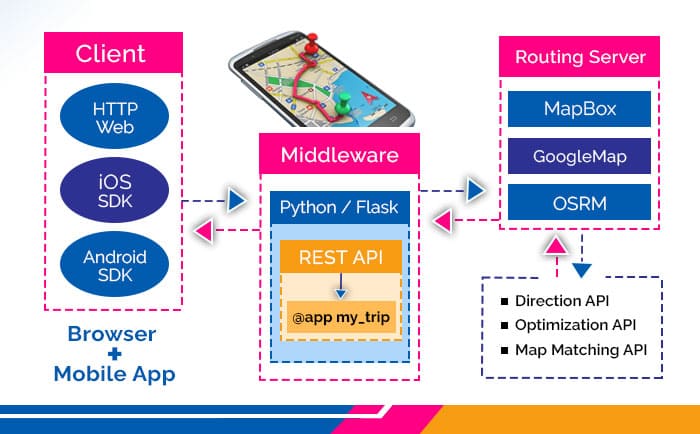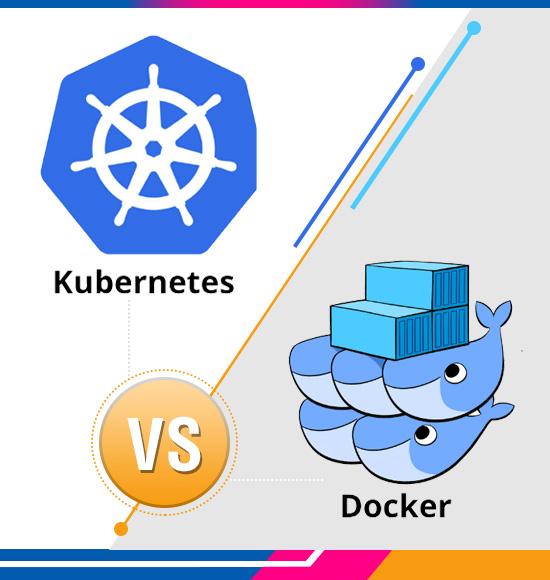GIS and Navigation Apps: How REST APIs and Python Middleware are Revolutionizing Routing Service (Part 1)
In today’s fast-paced world, people are always on the move, be it for work or leisure. With this increased mobility, there has been a corresponding increase in the demand for routing and navigation services. These services provide accurate and efficient routing information to users, allowing them to get to their destination in the most efficient manner possible.
Geographic Information Systems (GIS) and Python Middleware have been instrumental in making this possible.
In this blog, I’ll be providing the significance of GIS and the necessity of Middleware in routing and navigation apps. I will also delve into the development of client apps and middleware, and explore how REST APIs and Python Middleware are revolutionizing routing Services.
Architecture of a Routing and Navigation App: significance of GIS and Necessity of a Middleware
Navigation apps have become an essential part of our lives. Whether you’re driving or working, exploring a new city, taking a road trip with the most scenic routes, reaching a hospital in emergency through the fastest route with minimum traffic, or getting your favorite pizza delivered to you in no time.
Navigation apps help people to reach their destination faster and more efficiently. However, these apps rely on a complex network of APIs, middleware, and services to provide accurate and reliable directions.
Routing and navigation apps rely heavily on GIS (Geographic Information System), which is a computer-based system designed to, analyze, store, capture, manipulate, and display spatial and geographic data.
GIS allows apps to display maps, calculate distances, provide directions, and overlay location-based data such as traffic, weather, points of interest (POIs), etc. Without GIS, routing and navigation apps would not be able to function.

These Apps Require Some Algorithms and Routing Engines
It is important to note, GIS alone is not enough to provide users with efficient routing information. Routing and navigation apps require some algorithms and routing engines to solve the routing problem.
Some algorithms like Dijkstra, A*, and Chinese Postman as well as routing engines like OSRM (Open Source Routing Machine), Graphhopper, pgRouting, ORS (Open Route Service), Mapbox, Google, etc are used in GIS Systems. These algorithms are implemented in the form of Application Programming Interfaces (APIs). Usage of these APIs can be either free or subscription-based depending on the engine provider.
However, accessing these APIs directly from the app can be challenging. This is where Middleware comes in.
Middleware acts as a bridge between the client app and the routing APIs, handling complex tasks such as authentication, data preprocessing, and error handling.
Middleware can also cache frequently requested data to improve performance and reduce API usage costs. These APIs calculate the most efficient path between two points based on a variety of factors such as distance, time, traffic, waypoints, road types, road conditions, and driving profiles (drive, cycle, or walk).

How Python Helps to Implement a Middleware
Implementing a middleware requires a programming language like Python to receive the request and send responses from client apps to routing engines and vice versa.
This is where REST APIs come into play. REST (Representational State Transfer) APIs allow different software applications to communicate with each other over the Internet. Navigation apps use REST APIs to access routing service APIs such as Mapbox Navigation APIs, ORS APIs, and GoogleMaps APIs.
These APIs provide the core routing functionality, allowing the app to calculate and display the best route for the user.
Conclusion
To summarize, GIS and navigation apps rely on a complex network of technologies and services to provide accurate and reliable directions. REST APIs, routing service APIs, and Python middleware are just a few examples of the technologies powering these apps. As navigation apps continue to evolve; we can expect to see even more innovation in this space.
In the 2nd part of this blog, we will be learning about how a simple navigation app for web browsers can be developed using HTML, JavaScript, and Mapbox.




